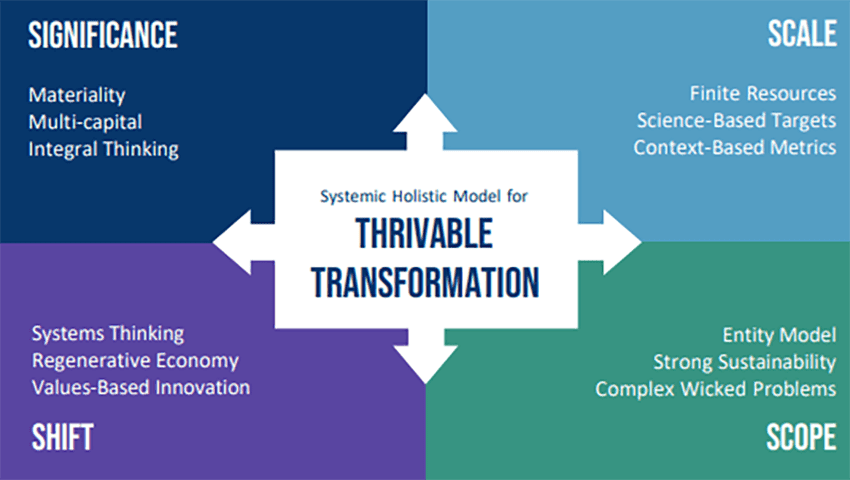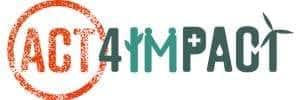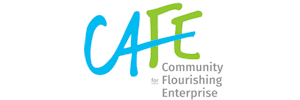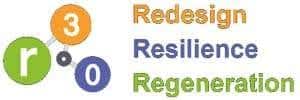Going Beyond Sustainability:
Embracing the THRIVE Framework for a Flourishing Future
Sustainability goals are not going to save the planet.
We need to build Holistic Regenerative Systems that helps humans and the planet flourish.
In other words, sustainability aims at net zero or reducing harm,, which is no longer enough. The THRIVE Framework offers a systemic, science-based approach and holistic strategies to create a future where both people and the planet flourish together, that is achieve thrivability.
Let’s discover how the THRIVE Framework uses proven research and global best practice in going beyond net zero to net positive to achieve thrivability for your organisation and the world.
The Systemic Holistic Model
The THRIVE Framework is a Systemic, Holistic Model consisting of 12 Foundational Focus Factors. Each factor measures a different facet of thrivability and empowers us to not only see how thrivable we are but also guide us on the effectiveness of our solutions.
Divided into four quadrants—Significance, Scale, Scope, and Shift—these factors move us from understanding the issues that we face to changing our actions.
From individuals and communities to organisations and even entire nations, anyone can use this to guide their decisions. Through these, we can see the path towards a thrivable future where we can reverse the harms on our planet and create a world where humanity lives in harmony with nature.

Significance Quadrant
The Significance quadrant of the Systemic Holistic Model is centered around understanding the issues we face and their impacts. To this end, it examines why we must address certain concerns and the consequences of failing to do so. These consequences include droughts, floods, forest fires, and other extreme events, all of which affect public health as well as political and economic stability. Significance also assesses the relevance and interdependencies of various types of resources, such as financial capital, intellectual capital, human capital, social and relational capital, and natural capital.

Multi-Capital
This recognises that financial capital is not the only form of value. Other types of capital, such as human, natural, intellectual, social, and constructed capital, also contribute value to a business. This approach aims to integrate risk management, strategy, and sustainability into financial reporting. A key element of sustainable reporting is the use of a Multiple Capital Approach (MCA), or multi-capital approach. MCA defines, measures, and quantifies various classes of capital, providing organisations with better information for decision-making and offering transparency to stakeholders about the impact of their activities.

integral Thinking
This is a theoretical framework that is holistic and interconnected. This approach measures the social, economic, and environmental impacts of any group, product, or service. It involves combining multi-capital thinking and reporting, going beyond the traditional triple bottom line (people, planet, prosperity).

Materiality
This refers to what is significant and relevant. What is important to one entity may not be so to another. It helps organisations focus on the key economic, environmental, and social issues that affect their business. Materiality plays a crucial role in sustainability reporting, guiding organisations to identify and prioritise the non-financial topics that are most relevant and impactful to their operations and stakeholders.
Scale Quadrant
The Scale quadrant of the Systemic Holistic Model builds upon the Significance quadrant and the various threats we face to examine their extent and how they must be managed. It considers the level of consumption of non-renewable resources and the implications of adverse climate issues on the world’s ecosystems, humanity, and economy. Scale emphasises the need to understand these issues organically, rather than perceiving them in isolation.

Context-Based Metrics
Context-Based Metrics (CBM) involve measuring the sustainability of a company based on the context in which it operates. Organisations use CBMs to allocate resources and set targets. CBMs provide a holistic, systems-based approach to inform how organisations should operate. Furthermore, CBMs help organisations adhere to sustainability thresholds in their resource allocation and the targets they pursue. This ensures that the metrics incorporate organisational context, sustainability thresholds, and normative values in alignment with the chosen approach.

Finite Resources
These are resources consumed faster than they can be replenished. Some, like trees, take only a few years to regenerate, while others, such as coal and oil, take millions of years to form. Renewable resources are those that are replenished continuously and without delay, such as wind and solar energy.

Science-Based Targets
These are goals informed by the latest scientific research. They provide a clear and measurable framework for governments and businesses to set emission reduction targets. These targets drive meaningful action, guided by up-to-date science and are crucial for fostering a culture of accountability and transparency, demonstrating to stakeholders that organisations take their environmental responsibilities seriously.
Scope Quadrant
The Scope quadrant of the Systemic Holistic Model focuses on the potential for Thrivability by recognising the diverse and ever-changing range of context-based threats and considering where efforts to enact change should focus. Strong approaches and a holistic perspective are essential to address these challenges effectively.

Complex Wicked Problems
These refer to social, cultural, political, or economic issues that are difficult to solve. The term “wicked” highlights the fact that many of these problems are hard to define, complicated, and defy conventional thinking or simple solutions. Many complex, wicked problems are further exacerbated by climate change, and often, solutions to one problem can create difficulties in other areas.

Entity Model
These aim to explore what entities are capable of. An entity can range from a small, single-celled organism to the entire cosmos. These models define the boundaries that outline their limits. THRIVE’s logo illustrates two crucial boundaries for humanity to respect in order to achieve thrivability. One is a social floor, representing the minimum conditions necessary for an entity’s survival. The other is an environmental ceiling, beyond which the environment can no longer recover from damage, depriving entities of the resources they need to survive.

Strong Sustainability
This ensures that entities recognise natural resources as finite and unexchangeable for money. Unlike weak sustainability, which focuses mainly on mitigating the worst impacts of climate change to ensure survival, strong sustainability emphasises allowing nature to regenerate, enabling ecosystems to recover and thrive. It also recognises that true prosperity must remain within the boundaries of what is compatible with the Earth’s ecosystems.
Shift Quadrant
The Shift quadrant of the Systemic Holistic Model emphasises the need for all sustainability approaches to move towards thrivability and suggests how these changes should happen. Achieving this requires consistent values, expertise from diverse disciplines, and a circular approach to sustainability.

Regenerative Economy
Our current economy is linear: products are mined or farmed, created, sold, and then disposed of. In contrast, a regenerative economy focuses on regenerating the environment and using products in a circular fashion. The goal is to reuse, recycle, and repair.

Systems Thinking
Our actions are interconnected with each other and the environment. Systems thinking offers a holistic way of understanding these interactions. The impact of one entity or system can affect another, either positively or negatively. Entities must recognise and consider their impacts, including those they may not immediately perceive.

Values-Based Innovation
This is driven by the principles we hold dear, including human life, thriving societies and ecosystems, fairness, social justice, and other initiatives aimed at creating a thrivable world. These values guide the innovation process, shaping the development of solutions to the complex and challenging issues we face.
Join Our Movement Today!
Together, we can create a future where all life thrives.
Sign up and learn how you can get involved.




















